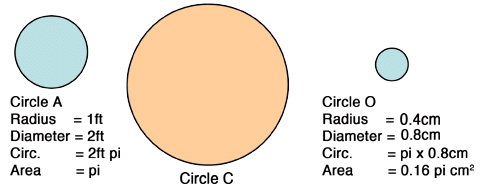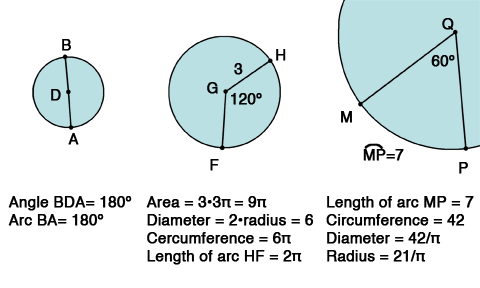Review
GRE Geometry - Circles
A circle is a set of all the points that are an equal distance from a common point called the center. The distance is called the radius, and twice the radius is called the diameter. Note that the diameter, by definition, passes through the center of the circle. Finally, the circumference of a circle is the distance around the circle, and is calculated as pi times the diameter. If you recall, pi is approximately 3.14, while the diameter is twice the radius. Most often, circles are designated by the letter that is given to the center point of the circle. For example, circles A, C and O are shown here, along with several diameters, circumferences, and radii.

| Summary of basic circula formulas | ||
| Diameter | 2r | |
| Circumference | (pi)(diameter) = (pi)*(2r) | |
| Area | (pi)(r2) | |
Circle topics that appear on more difficult GRE questions include Central Angles, Chords, Arc Measures, and Inscribed Polygon questions.
A central angle is the name given to an angle that has the vertex
as the center of a circle. In all cases, the total measure of the degrees in a circle is 360 degrees. Most often associated with central angle topics is the topic of an arc, which is a segment of the entire circumference. Most importantly,
the degree measure of an arc is equal to the central angle that forms the arc. Here are a few examples of circles, along with their interior angle measures and arc measures.
A central angle is the name given to an angle that has the vertex as the center of a circle. In all cases, the total measure of the degrees in a circle is 360 degrees. Most often associated with central angle topics is the topic of an arc, which is a segment of the entire circumference. Most importantly, the degree measure of an arc is equal to the central angle that forms the arc. Here are a few examples of circles, along with their interior angle measures and arc measures.

Notice that in the circle on the left, BA is the diameter, so the angle measure of BDA is one half of 360, or 180 degrees. Also, the extended arc angle measure is always the same as the interior angle measure. For the circle in the middle, you can arrive at the length of the arc HF by first calculating the diameter and then circumference of the circle, and then using the fact that 120 degrees is one-third of 360 degrees, you know that the length of the arc must be one-third of the circumference. In the circle on the right, note that you cannot see the entire circle, but you can infer the radius easily by noting that the arc MP has length 7, and since 60 degrees is one-sixth of the total 360 degrees of the entire circle, then the arc MP is one-sixth of the circumference, so the circumference is 6*7 =42. From then on, use the diameter and circumference relationships to arrive at the radius.